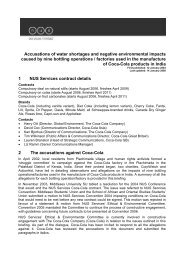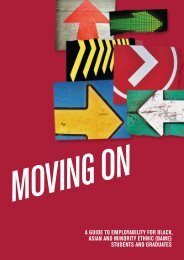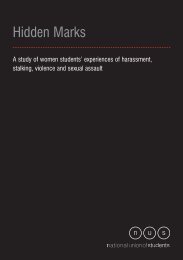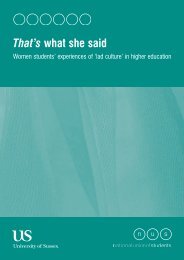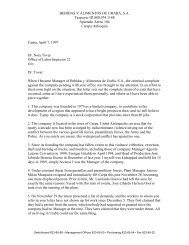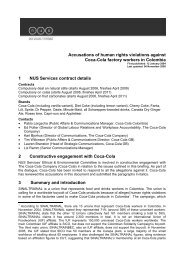No Place for Hate Crime - National Union of Students
No Place for Hate Crime - National Union of Students
No Place for Hate Crime - National Union of Students
You also want an ePaper? Increase the reach of your titles
YUMPU automatically turns print PDFs into web optimized ePapers that Google loves.
<strong>No</strong> <strong>Place</strong> <strong>for</strong> <strong>Hate</strong><br />
This chapter provides findings on how victims identify<br />
hate incidents and the environments in which they<br />
take place. It also provides demographic findings on<br />
perpetrators and victims, and on the relationships<br />
between them.<br />
For each incident type, we asked respondents who<br />
had been victimised to describe when and where the<br />
most serious incident had happened, why they believed<br />
it might be motivated by prejudice, and a number<br />
<strong>of</strong> questions regarding what they knew about the<br />
perpetrator(s).<br />
Apart from in cases <strong>of</strong> vandalism, property damage<br />
or theft (which predominantly occurred at or near<br />
victims’ homes), a large proportion <strong>of</strong> incidents<br />
occurred in and around further and higher education<br />
institutions. Although the respondents were all students,<br />
considering that they were asked to report experiences<br />
outside as well as inside institutions, it poses the<br />
question <strong>of</strong> whether campuses are ‘hotbeds’ <strong>of</strong> hate<br />
incidents and crime.<br />
While most perpetrators were reported to be strangers,<br />
in many incidents victims were nevertheless able to<br />
infer from the context or environment that perpetrators<br />
were students. Also corroborating other research<br />
was the finding that the large majority <strong>of</strong> perpetrators<br />
were males.<br />
Key findings<br />
• The majority <strong>of</strong> incidents – particularly those<br />
involving direct contact between the victim<br />
and perpetrator(s) – involved overt displays <strong>of</strong><br />
homophobia, through statements, gestures or<br />
symbols.<br />
• While students reported a range <strong>of</strong> locations in<br />
which they were targeted, a large proportion <strong>of</strong><br />
incidents occurred at the victim’s place <strong>of</strong> study<br />
– the exception being in cases <strong>of</strong> vandalism,<br />
property damage or theft, which predominantly<br />
occurred at or near the victim’s home. Moreover,<br />
many <strong>of</strong> these incidents occurred in the afternoon<br />
and evening, presumably during college and<br />
university campus open hours.<br />
• In 45 per cent <strong>of</strong> incidents prejudiced against<br />
the victim’s sexual orientation or gender identity,<br />
the perpetrator(s) were believed to be students –<br />
<strong>of</strong>ten fellow students at the victim’s institution.<br />
• The bulk <strong>of</strong> reported incidents were perpetrated<br />
by white male assailants, <strong>of</strong>ten young people<br />
in groups, who were not known by the victim.<br />
In 44 per cent <strong>of</strong> incidents involving a single<br />
perpetrator, the assailant was thought to be a<br />
student. At least one student was believed to be<br />
involved in 55 per cent <strong>of</strong> cases involving multiple<br />
perpetrators.<br />
30



